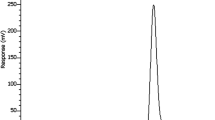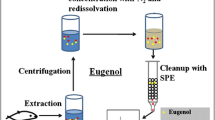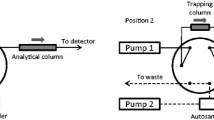Abstract
The aim of this study was to optimize the separation of biogenic amines with ion-exchange high-performance liquid chromatography, using the modified simplex method. A modified chromatographic response function was used, and two methodological parameters were selected as simplex variables: the proportion of the organic solvent 2-propanol in the mobile phases, added as a new mobile phase, and the variation of the gradient curve at one specific step in the elution program. In optimum conditions the correct resolution and separation of the biogenic amines (tyramine, β-phenylethylamine, histamine, tryptamine, putrescine, cadaverine, agmatine, spermidine and spermine) were completed in 16 min, reducing the analysis time by 9 min compared with the original method. The regression coefficients were higher than 0.99 in all the amines, except for spermine (0.989). The detection limits varied between 0.06 mg/L, for histamine and agmatine, and 0.22 mg/L, for tryptamine, while retention time repeatability, determined as a relative standard deviation, was between 4.64% for histamine and 11.95% for tryptamine. The repeatability variation for the amine concentrates was found between 0.71% in cadaverine and 3.23% for tryptamine. Applying the optimized method to samples of refrigerated sardine and sea bream demonstrated the effectiveness of the method in these fish species.



Similar content being viewed by others
References
Ruiz-Capillas C, Moral A (2001) Production of biogenic amines and their potential use as quality control indices for hake (Merluccius merluccius, L.) stored in Ice. J Food Sci 66:1030–1032
Ruiz-Capillas C, Moral A (2004) Sensory and biochemical aspects of quality of whole bigeye tuna (Thunnus obesus) during bulk storage in controlled atmospheres. Food Chem 89:347–354
Lapa-Guimarães J, Pickova J (2004) New solvent systems for thin-layer chromatographic determination of nine biogenic amines in fish and squid. J Chromatogr A 1045:223–232
Özogul F, Özogul Y (2006) Biogenic amine content and biogenic amine quality indices of sardines (Sardina pilchardus) stored in modified atmosphere packaging and vacuum packaging. Food Chem 99:574–578
Önal A (2007) A review: current analytical methods for the determination of biogenic amines in foods. Food Chem 103:1475–1486
Al Bulushi I, Poole S, Deeth HC, Dykes GA (2009) Biogenic amines in fish: roles in intoxication, spoilage, and nitrosamine formation—a review. Crit Rev Food Sci Nutr 49:369–377
Kim MK, Mahb JH, Hwang HJ (2009) Biogenic amine formation and bacterial contribution in fish, squid and shellfish. Food Chem 116:87–95
Ruiz-Capillas C, Jiménez-Colmenero F (2009) Biogenic amines in seafood products. In: Nollet LML, Toldrá F (eds) Handbook of seafood and seafood products analysis. CRC Press and Taylor & Francis, Boca Ratón, pp 833–846
Bakar J, Yassoralipour A, Bakar FA, Rahman RA (2010) Biogenic amine changes in barramundi (Lates calcarifer) slices stored at 0 °C and 4 °C. Food Chem 119:467–470
Simat V, Dalgaard P (2011) Use of small diameter column particles to enhance HPLC determination of histamine and other biogenic amines in seafood. Food Sci Technol-Leb 44:399–406
FDA, Food and Drug Administration (2011) Scombrotoxin (histamine) formation. In: Fish and fisheries products hazards and controls guidance, 4th edn. Food and Drug Administration, Center for Food Safety and Applied Nutrition, Office of Seafood, Washington, DC, pp 113–151
European Commission (EC) (2003) Commision recommendation of 10 January 2003 concerning a coordinated programme for the official control of foodstuffs for 2003 (2003/10/EC). Official J European Commission 7:76–81
Lehane L, Olley J (2000) Histamine fish poisoning revisited. Int J Food Microbiol 58:1–37
Ruiz-Capillas C, Moral A (2001) Effect of controlled atmospheres enriched with O2 in formation of biogenic amines in chilled hake (Merluccius merluccius, L.). Eur Food Res Technol 212:546–550
Chytiri S, Paleologos E, Savvaidis I, Kontominas MG (2004) Relation of biogenic amines with microbial and sensory changes of whole and filleted freshwater rainbow trout (Onchorynchus mykiss) stored on ice. J Food Protect 67:960–965
Karmas E (1981) Biogenic amines as indicators of seafood freshness. Lebensm Wiss Technol 14:273–275
AOAC (2005) Association of Official Analytical Chemistry. Histamine in seafood, fluorometric method, 977.13. In: Official Methods of the Analysis of AOAC International, 18th edn. Gaithersburg
Lange J, Thomas K, Whittmann C (2001) Comparison of a capillary electrophoresis method with high performance liquid chromatography for the determination of biogenic amines in various food samples. J Chromatogr B 779:229–239
Alberto MR, Arena ME, Manca de Nadra MC (2002) A comparative survey of two analytical methods for identification and quantification of biogenic amines. Food Control 13:125–129
Zhao QI, Xu J, Xue CH, Sheng WJ, Gao RC, Xue Y, Li ZJ (2007) Determination of biogenic amines in squid and white prawn by high-performance liquid chromatography with postcolumn derivatization. J Agric Food Chem 55:3083–3088
Triki M, Jiménez-Colmenero F, Herrero AM, Ruiz-Capillas C (2012) Optimisation of a chromatographic procedure for determining biogenic amine concentrations in meat and meat products employing a cation-exchange column with a post-column system. Food Chem 130:1066–1073
Wehrens R, Buydens LMC (2000) Classical and nonclassical optimization methods. In: Meyers RA (ed) Encyclopedia of analytical chemistry. John Wiley & Sons Ltd, Chichester, pp 9678–9689
Guillaume YC, Peirin E (2000) Optimising mobile phase composition, its flow-rate and column temperature in HPLC using taboo next term search. Talanta 51:579–586
Srijaranai S, Burakham R, Deming RL, Khammeng T (2002) Simplex optimization of ion-pair reversed-phase high performance liquid chromatographic analysis of some heavy metals. Talanta 56:655–661
Kuppithayanant N, Rayanakorn M, Wongpornchai S, Prapamontol T, Deming RL (2003) Enhanced sensitivity and selectivity in the detection of polycyclic aromatic hydrocarbons using sequential simplex optimization, the addition of an organic modifier and wavelength programming. Talanta 61:879–888
Bostyn S, Cagnon B, Fauduet H (2009) Optimization by the simplex method of the separation of phenolic acids by high-performance liquid chromatography in wastewater olive and sugar beet vinasse. Talanta 80:1–7
Berridge JC (1989) Simplex optimization of high-performance liquid chromatographic separations. J Chromatogr 485:3–14
Tabera J (1989) Aplicación del método Simplex en la optimación de técnicas cromatográficas. I. Fundamentos y teoría. CTA 10:139–145
Tracy ML, Pickering MV, Verhulst T (1995) Cation exchange analysis of foods and beverages for biogenic amines. Food Testing Anal 1:48–50
Shalaby AR (1996) Significance of biogenic amines to food safety and human health. Food Res Int 29:675–690
Karnka R, Rayanakorn M, Watanesk S, Vannesorn Y (2002) Optimization of High-Perfomance Liquid Chromatographic parameters for the determination of Capsaicinoid compounds using the simplex method. Anal Sci 18:661–665
FAO (2009) Fisheries Department, Fishery Information, Data and Statistics Unit. FISHSTAT Plus: Universal software for fishery statistical time series. Version 2.32
Mendes R (1999) Changes in biogenic amines of major Portuguese bluefish species during storage at different temperatures. J Food Biochem 23:33–43
Vidal-Carou MC, Lahoz-Portolés F, Bover-Cid S, Mariné-Font A (2003) Ion-pair high-performance liquid chromatographic determination of biogenic amines and polyamines in wine and other alcoholic beverages. J Chromatogr A 998:235–241
Mackie IM, Pirie L, Ritchie AH, Yamanaka H (1997) The formation of non-volatile amines in relation to concentrations of free basic amino acids during postmortem storage of the muscle of scallop (Pecten maximus), herring (Cuplea harengus) and mackerel (Scomber scombrus). Food Chem 60:291–295
Ruiz-Capillas C, Jiménez-Colmenero F (2004) Biogenic amines in meat and meat products. Crit Rev Food Sci Nutr 44:489–499
Koutsoumanis K, Lampropoulou K, Nychas GJE (1999) Biogenic amines and sensory changes associated with the microbial flora of Mediterranean gilt-head sea bream (Sparus aurata) stored aerobically at 0, 8, and 15 degree C. J Food Protect 62:398–402
Paleologos EK, Savaidis IN, Kontominas MG (2004) Biogenic amines formation and its relation to microbiological and sensory attributes in ice-stored whole, gutted and filleted Mediterranean Sea bass (Dicentrarchus labrax). Food Microbiol 21:549–557
Acknowledgments
This research was supported under projects FAIR CT 98-3899 and the project AGL2008-04892, AGL2010-19515/ALI and CSD2007-00016 of the Programa Consolider Ingenio 2010 of the Plan Nacional de Investigación Científica, Desarrollo e Innovación Tecnológica (I+D+I).
Author information
Authors and Affiliations
Corresponding author
Rights and permissions
About this article
Cite this article
Sánchez, J.A., Ruiz-Capillas, C. Application of the simplex method for optimization of chromatographic analysis of biogenic amines in fish. Eur Food Res Technol 234, 285–294 (2012). https://doi.org/10.1007/s00217-011-1622-6
Received:
Revised:
Accepted:
Published:
Issue Date:
DOI: https://doi.org/10.1007/s00217-011-1622-6




